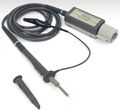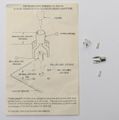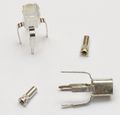P6230: Difference between revisions
No edit summary |
No edit summary |
||
| Line 17: | Line 17: | ||
The '''P6230''' has an offset control potentiometer in the termination box and connects to the scope, e.g. [[7000 series scopes]], through a [[BNC connector]] with ×10 readout pin. It can be powered from 7000 series mainframes having [[LEMO S-series connector]]s for probe power, or compatible units such as the [[1101]]. | The '''P6230''' has an offset control potentiometer in the termination box and connects to the scope, e.g. [[7000 series scopes]], through a [[BNC connector]] with ×10 readout pin. It can be powered from 7000 series mainframes having [[LEMO S-series connector]]s for probe power, or compatible units such as the [[1101]]. | ||
The '''P6231''' is a | The '''P6231''' is a TekProbe Level 2 probe intended for 11000 series plugins such as the [[11A32]] or [[11A71]]. Offset control and power are provided by the scope mainframe through a [[Tekprobe BNC connector]]. | ||
The P6230/6231 shares accessories with many other Tektronix [[subminiature modular probes]] although the input hybrid is unique. Tip color is yellow, connector end color is blue, part number [[206-0279-00]]. Its end to end resistance is 400 Ω. | The P6230/6231 shares accessories with many other Tektronix [[subminiature modular probes]] although the input hybrid is unique. Tip color is yellow, connector end color is blue, part number [[206-0279-00]]. Its end to end resistance is 400 Ω. | ||
| Line 124: | Line 124: | ||
[[Category:Subminiature modular probes]] | [[Category:Subminiature modular probes]] | ||
[[Category:50 Ω Oscilloscope probes | [[Category:50 Ω Oscilloscope probes]] | ||
Revision as of 06:32, 2 August 2023

The Tektronix P6230 and P6231 are passive ×10 (450:50 Ω) probes with 1.5 GHz bandwidth and DC offset capability, intended to minimize DC probe-loading effect when used on logic circuits.
The P6230 has an offset control potentiometer in the termination box and connects to the scope, e.g. 7000 series scopes, through a BNC connector with ×10 readout pin. It can be powered from 7000 series mainframes having LEMO S-series connectors for probe power, or compatible units such as the 1101.
The P6231 is a TekProbe Level 2 probe intended for 11000 series plugins such as the 11A32 or 11A71. Offset control and power are provided by the scope mainframe through a Tekprobe BNC connector.
The P6230/6231 shares accessories with many other Tektronix subminiature modular probes although the input hybrid is unique. Tip color is yellow, connector end color is blue, part number 206-0279-00. Its end to end resistance is 400 Ω.
Key Specifications
| Bandwidth | DC to ≥ 1.5 GHz |
|---|---|
| Rise time | ≤ 230 ps |
| Attenuation | 10× |
| Input Impedance | 450 Ω // 1.3 pF (1.6 pF guaranteed) |
| Signal delay | 8.7 ± 0.1 ns |
| DC offset | –5 V ≤ (Vsignal + Voffset) ≤ +5 V |
| Features |
|
Internals
The P6230/6231 probes are sometimes described as FET probes or active probes, however, as the circuit diagram clearly shows, this is not correct. After the 400 Ω input hybrid, the AC component of the input signal is connected directly to the scope input through a 1 μF capacitor, then terminated in 50 Ω either in the scope input or the switchable terminator. The active circuit in the P623x, a standard NE5532 dual opamp, has the function of restoring and offsetting the input signal's low-frequency and DC components. This approach is similar to the feed-beside technique used in the 7104 scope and 7A29 amplifier.
Tek explains the raison d'être for the P6230/P6231 thus:
The P6230 acts as a standard 500 Ω passive voltage probe with the additional capability of having an adjustable tip "nulling voltage." This feature reduces the dc-loading effects on the probe when it is used to measure signals whose mid-voltage value is other than zero volts, or in circuits where the termination impedance is returned to other than ground level. The Input Bias/Offset Voltage may be adjusted so that at a particular test-signal voltage both ends of the probe input-resistor are at equal potentials and no current is flowing through the resistor.
ECL logic is most commonly operated from a -5.2 V supply with Vcc connected to ground. The output of an ECL gate is the emitter of an NPN emitter follower stage. The output is pulled down to a negative supply (about -2 V) with an external resistor (50 Ω to 100 Ω). Since speed is a major consideration in ECL designs, the interconnections between gates are often transmission lines, and the pull-down resistor doubles as a line termination.
If a standard 500 Ω, 10× probe without the input Bias/Offset feature were used to examine an ECL output, the probe's 500 Ω resistance to ground would form a voltage divider with the gate's output-termination resistor. This divider can cause distortion of the output signal levels, shift the DC operation point of the output transistor, and reduce the gate's noise margin.
The DC-load nulling capability of the P6230 helps to solve this problem. By adjusting the Input Bias/Offset Voltage to the ECL low level or to the termination voltage, the only effect of the probe resistance will be a small decrease in the ECL output-termination resistance. The effect of the probe on output voltage levels is negligible.
Links
Prices
| Year | 1984 | 1987 | 1989 | 1991 | 1995 |
|---|---|---|---|---|---|
| P6230 Catalog price | $385 | $395 | $420 | $525 | – |
| In 2022 Dollars | $1,100 | $1,030 | $1,000 | $1,140 | – |
| P6231 Catalog price | – | $410 | $410 | $525 | $799 |
| In 2022 Dollars | – | $1,070 | $980 | $1,140 | $1,550 |
Pictures
-
P6230 compensation box
-
P6230 Switchable terminator
-
P6230 Compensation box interior
-
P6230 Compensation box interior
-
P6231
-
P6230 probe tip with alligator clip ground lead
-
Probe tip components
-
Low-inductance ground lead
-
-
-
Probe-to-PCB adapters
-
Probe-to-PCB adapters
-
P6230 circuit diagram
-
P6230 input impedance graph
Measurements
-
P6230 Rise time without ground lead: 9.2 * 20 ps = 184 ps (equiv. to 1.9 GHz bandwidth)
-
Effect of using the "low inductance" ground lead - rise time 400 ps, bandwidth 875 MHz
-
Using the 250 mm alligator ground lead - severe pulse distortion, rise time ~3 ns (115 MHz)!
-
Bandwidth vs. grounding, from manual




















